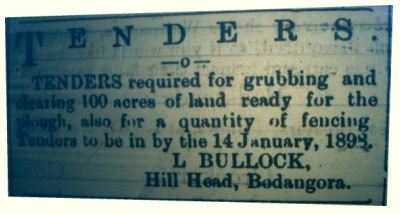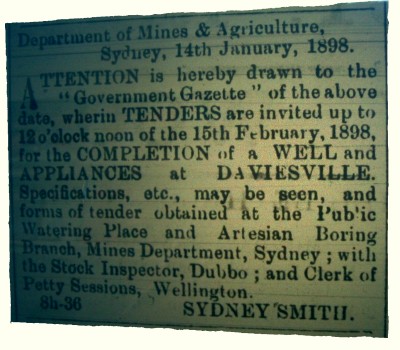Locations of Houses & Businesses
Sign my Guestbook
 View my Guestbook
View my Guestbook
| View this page at 1024x768
Contact Webmaster
This page last updated Feb 2009.
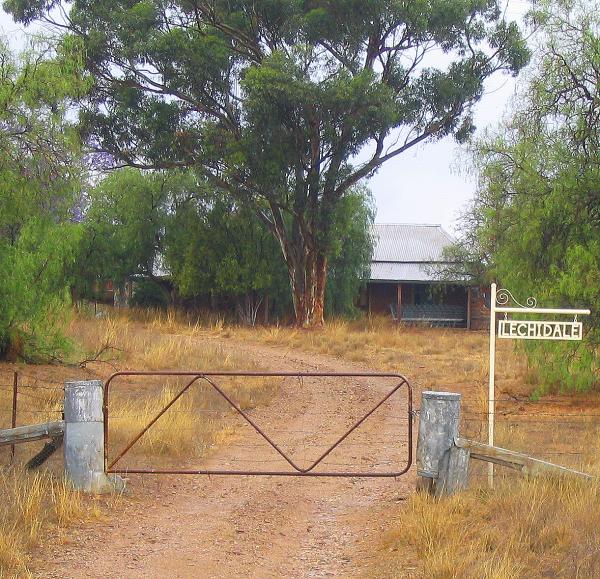
'Lechidale' 2006
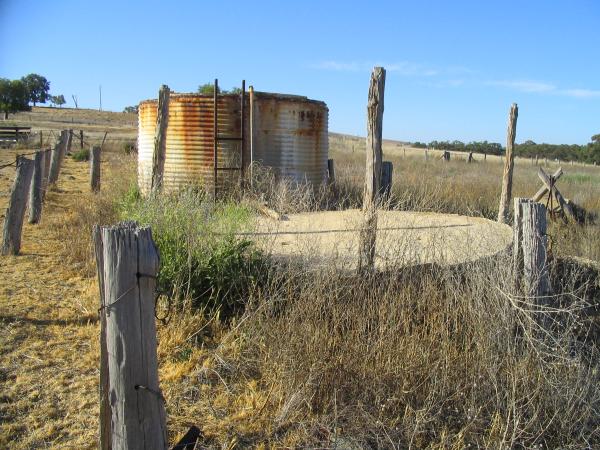
The original Daviesville Well
|
Farming in the Bodangora District
As mentioned on the home page, the area around what is now known as the village of Bodangora was originally part of 'Nanima' estate, being mainly used for the grazing of sheep. As the area became populated, much of the old 'Nanima' estate was thrown open for closer settlement, and blocks were put up for ballot - which is how many of the existing properties originated. Among the earliest properties in the district was 'Lechidale', which was taken up by Thomas Henry Knowles in 1870. This was around the same time as the discovery of the alluvial goldfield known as 'Old Jawbone', with the original homestead being built close by. Another pioneering family were Nicholas & Elizabeth Cooney who moved from nearby Gulgong and took up land they called 'Avondale'.
A flour mill had opened up in Dubbo by 1873, so supposedly many of these early pioneers had recognised the suitability of the area to the growing of wheat. Certainly the area was well cultivated in September 1898 when Mr. R.G. Dulhunty, the Govt. stock inspector from Dubbo, wrote the article on this page, as appeared in the Wellington Times. Mr. Dulhunty was doing a tour of inspection, and had business concerned with the Daviesville Common, which is adjacent to the Wellington, Mudgee road, and also to Bodangora township. A stock watering point, also known as 'Daviesville Well', is adjacent to this main road and near the 'Lechidale' homestead.

A 2006 image looking past 'Daviesville Well' and across the Common to Bodangora hill. The chimney is visible above the right side of the closest tank. The remains of some diggings from the northern end of the 'Old Jawbone Lead' are still clearly visible. The airstrip has been located here for many years.
|
ACCIDENT TO MR. KNOWLES
Wellington Times - February 17 1898
'An accident happened yesterday to Mr. Knowles of 'Lechidale', but we are glad to say without serious consequences to himself. He was driving a horse and sulky from Wellington, and had in the sulky two bars of iron which he was taking home. At the Bodangora turn off, one of the bars fell out of the vehicle, and the horse bolted along the Wuuluman road. As the way was clear, Mr. Knowles let him go till he had had apparently a bellyfull. The horse was then brought back to where the bar of iron had fallen out, and Mr. Knowles got out and replaced it in the vehicle, but no sooner did the horse hear the clink of iron that he plunged away again. Mr. Knowles caught him by the head and struggled to stop him, but was thrown down and trampled upon, and had to let go. The animal then went off at full speed towards Wellington, the trap was smashed shortly afterwards, and the horse continued his career with flying traces round Mr. Scott's residence to the Gobolion road, where someone stopped him and brought him back. Mr. Knowles was picked up by, we believe, Mr. Dupin who was passing in a cart, and brought into town. Mr. Knowles was cut about the face and hands, and received a shock to his nerves, but managed to ride the horse back home. The horse was considerably damaged about the legs'.
|
A TRIP AMONGST THE WHEAT
To the editor of the Dubbo 'Liberal' (1898)
'Sir, - Having some business for my Department to attend to, connected with the Commons at Wellington and Daviesville, or as it is now called Bodangora (a much better name in my humble opinion), I started away from Dubbo, accompanied by a chum who often drives me round my district when on my periodical visits of inspection, and finds and drives one of the best pair of buggy horses in the district, (and you bet he can drive them too). He is a first rate mate, but has one bad fault: he won't either drink whiskey or smoke, but has some choice yarns to beguile the time with. We left Dubbo on Friday and drove along the railway line up to Wellington, through the farms of Mr. Morley, John Whitley, Hubbard Bros., Giddings, Konza, Stephenson, C.H.Barton, Dowd, and A'Beckett. Virtually, miles of wheat on either side of the road, standing from one to three feet high, and promising by present appearances between 30 and 40 bushels to the acre - and there are many thousands of acres - and all the grass lands looking splendid. Horses, cattle and sheep all fat as whales. Passing 'Gobolion', the residence of Squire Gardiner, we saw a man with five very fine draught horses and a three furrow disc plow turning up a very foul weedy paddock and doing splendid work. This is the first of these ploughs I have seen actually at work, and I was much struck with the work it was doing, as I had heard all sorts of reports about them. The driver told us he had only started after lunch that day, and I should say he had done quite 2 1/2 acres, and done it well. I think this plough will supersede all others with any farmers who can afford them, as at present they are very dear; £40 is about their cost. Arriving at Wellington, I interviewed the common trustees, and found them all too busy to go with me to show me what they wanted, so arranged for them to meet me on the ground at 9 o'clock next morning, and went on to 'Apsley', Mr. R.T.B. Gaden's beautiful homestead, four miles further on up the Macquarie River. Here there are some hundreds of acres under wheat, looking magnificent, also large lucerne paddocks. Here also Mr. C.B. Gaden showed us his patch where he grows the wonderful things that he brings to our Dubbo show and scoops the whole pool; and from what we saw, I should say his exhibit next year will be superior to anything he has yet shown us. After spending the night at 'Apsley', we started early next morning and met with the common trustees at the appointed time, settled our business with them, and started on for Bodangora. (By the bye, this place, before it became such a famous gold mine, was called Tenandra). Travelling along the road from Wellington to Mudgee - a splendid metalled road with wheat fields on either side of it as far as the eye can reach - about one mile out Mr. Nancarrow is building a fine stone residence on a splendid eminence some distance back from the road; a nice wooded hill, with a cleared paddock of 50 or 60 acres of splendid wheat in front of it. Most of the land about here and for some miles further on was purchased from the 'Nanima' estate, and a large proportion of it cost £3 15s per acre. Here also you look down on the 'Towri' estate, where they have this year about 5,000 acres under cultivation, besides running some 5,000 sheep and a lot of cattle and horses; it looks like a sea of wheat, and is surrounded on all sides by field after field of wheat as far as you can see, and is a sight worth anyone's while to go and have a look at. And only a few years ago I used to do kangaroo hunting there with Ernest Matthews, Captain Brown, Jack Smith, and a lot of others, when it was mostly all thick box and pine scrub on to Bodangora, which is a thriving little village on the slope of a high ridge, with a population of about 300 people, all more or less supported by the mine, and there is not one hotel or liquor shop in the whole place, which looks clean and prosperous. Finishing my business with the common trustees, we went on to Mitchell's Creek, crossing that creek at Mr. William Trevaskis's farm of 640 acres which he purchased some years ago from the 'Nanima' estate at £2 5s 6p per acre, and out of which he has done so well that he would not sell for double that money just now. Just here there is a fine building kept as a convent and inhabited by some Sisters of Mercy, who teach the children of their religion (I presume), as there is a fine public school at Bodangora presided over by our old Dubbo friend, Percy Kable. From here right down the creek, passing the farms of Messrs. Bernasconi, W.F.Wilson, Lyons, Smith, Toynton and Hennessy to 'Bodangora Station', lately purchased from the Bank of New South Wales by Messrs. Martin Bros., and formerly owned by my old friend, Jim Rodda. Here we had lunch, and then, getting saddle horses and accompanied by Mr. Martin, we rode all over the run; and my word, it was an eye opener for me; the whole place is ringbarked, cleared, scrubbed, cropped and improved completely out of my recognition, and though I have known the place for forty years, I could not have found my way home when once I got out in the paddocks, if no one had been with me. There are about 200 acres of wheat on this place, looking like all the rest splendid. One thing that struck me as strange was that with such a magnificent agricultural district, and such an immense area under cultivation, the township of Wellington is not as big as Bathurst instead of being as it still is, a small village. After spending the night here, and being hospitably entertained by Messrs. Martin Bros., and hearing some very interesting anecdotes, we started on Sunday morning, and going right down Mitchell's Creek, passing through the farms of Messrs. McLeod ??-- Alf Williams, Michael Finn and the Rosses, all beautiful farms, with pretty and comfortable homesteads, and grand crops, we got onto Jim Rutherford's country, and we were pleased to see abundance of grass and water all over it, and stock looking in great condition. Jim is busy shearing and I should say by the look of his sheep that he will have a big lot of bales. Then on to 'Barbigal' for lunch. Here again the place is improved out of all recognition. This is now one of the prettiest homesteads in the district, all the timber being cleared in front of the house. There is a grand look-out on some 500 acres of cultivation, bounded by the tall gum trees which fringe the Talbragar river, with beautiful high wooded hills on the opposite side. A lot of this estate is being let on the halves system, and as there is any amount of splendid wheat land on it, and it is close to the railway, it should pay anyone who goes into it handsomely. The estate consisted of some 20,000 acres of secured land besides leasehold, and was mostly put together by my old friend Jim Sparkes (whose widow and family live there), and will one day be one of the most valuable in the district. It is managed by Mr. W.H.Baker, who has the reputation of being a past master at driving a bargain. Leaving here after lunch we got back to Dubbo in time for six o'clock dinner, well pleased with our trip and all we saw, the weather at this time of year being simply perfect'.
R.G.Dulhunty
September 19, 1898

Harvesting of wheat at 'College Green', Bodangora - pre WW1
Pic courtesy of Rex England, 'Panorama', Bodangora.
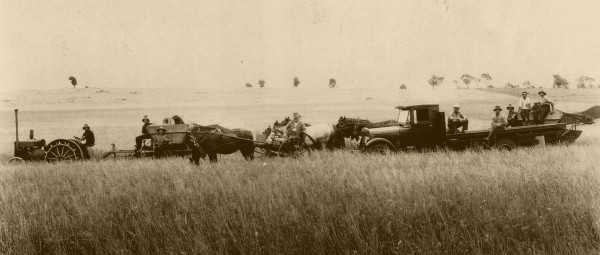
Harvesting of wheat at 'College Green', Bodangora around 1935. What a great picture! Note at the back behind the new tractor is a horse drawn header. And the old and the new in the foreground as well.
Pic courtesy of Rex England, 'Panorama', Bodangora.
|

Pic courtesy Gae Drew
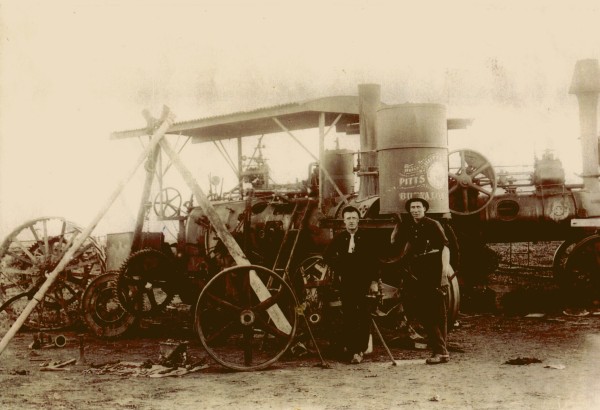
Pic courtesy Gae Drew
|
Steam Power
At the end of the 1800's, & the first part of the 1900's, the use of steam power was in use in many aspects of farming. The steam traction engines, such as in these photos, must have been an impressive sight as they worked in the Bodangora district.
Families such as the Mostyn family from Maryvale, not far from Bodangora, made their living during this time as chaff cutters. The Mostyn chaff cutters travelled the district, working under contract.
In this photo at left can be seen the steam traction engine providing the power to drive the chaff cutter, by means of a drive belt from the large flywheel.
The second photo shows the Mostyn family workshop at Maryvale. Other families to cut chaff in the district were the Duttons and the Reinbergers.
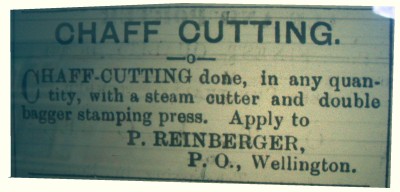
Wellington Times - Jan 6 1898
|
Wellington Times
Thursday, November 17, 1927
BODANGORA
The 'Has Been'
(WS)
'There are some people and some towns, if they get a set back in the world, seem never to be able to rise again in the van of progress, and in some cases they do not. When the great mine shut down, after running for nearly fifty years, and turned out £250,000 in solid gold, not because the reef had been worked out, which is not the case, but owing to wages and chemicals having advanced to over double, whilst gold has remained at the same price, hence the closing down of the mine. It is true that the large population, that was resident in Bodangora, when the miners were working, has gone, that is but natural, but in its place remains a rural population, whose interests are in other directions than mining. Much of the lands that were held for mining have passed into agriculture'.
'Before commenting on the farms embraced in Bodangora area, perhaps a comment on the 'has been' village may be of interest. A daily mail comes to an up-to-date modern post office, which has telephone, Commonwealth savings bank and money order branches. The police station and public school are modern and comfortable buildings. There is a good general store, at which all requirements can be filled, and the leading newspapers of the State can be purchased. The churches are four in number. that of the R.C. being a fine structure of blue stone and imposing architecture. There is a public library in the Mechanics' Hall. The books of the library comprise, science, travel, history, biography, fiction, and other branches of literature - some 4,000 volumes, many bound in leather and morocco. The late Mr. Dick made a valuable donation of books to the institute. There is a 12 acre park, which is vested in in trustees, the trees being well grown. In the park is the Soldiers' memorial, which was erected by the people to the memory of the men who enlisted in the Great War, and which was unveiled by the late Governor, Sir Walter Davidson. The buildings of the residents are comfortable and clean, and most have garden plots. Infectious diseases arely occur, and are nearly always introduced from elsewhere. one of the finest Wellington views is to be had from from the hill of the 'has been'. An asset of which the people are very jealous is the local common, and repeated attempts of land seekers have been defeated by them'.
'In regard to the methods of farming, a short description maybe of interest. Taking the large holdings that combine grazing and farming, 'Bodangora Station', Martin Bros. (Manager Mr. Bird) carries many sheep as well as share-farms; methods, horse power; out buildings, good shearing machines in shearing shed, lucerne and ensilage'.
'J.O.V. Reid, mixed farming with share farmers; method tractors and horses'.
''Glen Mitchell' the property of Mr. A. McConochie, has one of the finest homesteads in the Wellington district, with all modern appointments; sheep; share farming is carried out on this property; lucerne and ensilage are very prominent and many fat sheep and lambs are sent to market; power used in farming, horses'.
'Dowd and Sullivan, mixed farming, all land is fallowed year previous to sewing, areas amounting to 1200 acres put in some years, by horse power'.
'Morley Bros., mixed farming, much fallowed land is cropped; power, tractor and horses'.
''Nyrang', R.M. Smith and Sons, mixed farming, fine homestead and out buildings, system of fallowing carried out; power, tractor and horses'.
'Thomas Quirk, 'Gladstone', mixed farming carried on fallow ploughing; good homestead and outbuildings; sheep; recognised Clydesdale horse breeder; power used on farm, horses'.
'R. Conn, mixed farming, fallowing system followed, motive power used, farm horses'.
'Gibbs Brothers 'Daviesville' mixed farming, fallowed land only cropped; power used, horses'.
'E.J. Bullock, 'Hill Head', stone homestead, mixed farming, fallow system followed. This farm is one of the few mentioned in the farm pamphlets issued by the Better Farming Train. An up-to-date dairy, fitted with suction milking machines; the dairy herd has many high grade jerseys; pigs are also kept; power used, horses, except in dairy, power and shearing shed'.
'Neil McLeod, 'Inverness', mixed farming, lucerne, fallow system; homestead, brick; fine outbuildings; farm power, horses'.
'O. Frogley, fallow system, mixed afrming; power used; horses'.
'W.B. and N. Lyons, 'Mt. Bodangora', mixed farming, share farming, fallow system; fine brick homestead; power used, tractor and horses; lucerne and ensilage conserved for dry season'.
'Thos Gibbs, 'Lincoln', wheat growing only, fallow system carried out'.
'H.J. Knowles 'Lechidale', mixed farming system, fallow; stone homestead and good out buildings; a frequent exhibitor with fat sheep at Wellington Show; power used, horses'.
'W. Althofer, 'Carlyle', mixed farming, system fallowing, good homestead, garden and orchard, power used, horses'.
'Campbell Bros., 'Argyle', mixed farming, fallowing system, brick homestead, excellent outbuildings and shade trees; power used on farms, tractor and horses'.
'Henry England, 'Strathmore', mixed farming, good homestead with outbuildings; fallow system carried out; has sent the first wheat to Wellington market this year; power used on farm, horses'.
'Don Neville, mixed farming, fallow system carried out on farm; provision made by ensilage for dry seasons; good homestead; power used, horses'.
'Gosper Bros. fallow system; power used tractor; good homestead and outbuildings.
'Such are some of the farmers whose methods of farming around Bodangora have put them in the van of progress and has prevented the 'has been' being an accomplished fact'.
|
 View my Guestbook
View my Guestbook
